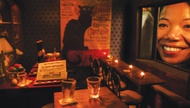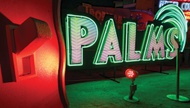The backstory is exceptionally cool. Local writer Matthew O’Brien writes a book called Beneath the Neon that local artist Brian “Paco” Alvarez reads. Moved by its subject matter, Alvarez feels compelled to curate an installation based upon the text. The Contemporary Arts Collective agrees to be the venue. Each attempts to offer a necessary glimpse into the very real experience of Las Vegas’ immense system of storm drains, home to a subterranean city that thrives beneath our own.
Alvarez has worked hard to re-create the cave-like tunnels in the large main gallery, and he has undeniably transformed the space. Walls are soaked in spray-painted murals; clutter and gravel crowd the shallow space where the wall meets the floor; a modest living area has been re-created. A number of graffiti artists who live and/or work in the storm shafts were invited to create fresh pieces for the walls, thrillingly fantastic testaments to the vibrant life force present in the tunnels.
More
- Beneath the Neon
- ***
- Through July 24
- Contemporary Arts Collective, 101 Charleston Blvd. Suite 101. 382-3886
- Beyond the Weekly
- Underground Gallery (Las Vegas Sun, 5/27/08)
- Beneath the Neon by Matthew O'Brien
In apparent contrast is a curtained-off space to the left of the main door. It’s a jarringly neutral museum experience, containing a map of the tunnels, a short video/documentary, artifacts from the author’s excursions and gorgeous photographs from those trips. Not to take away from the incredibly beautiful and moving photographs by Danny Mollohan, but the “art” in this room is the curator’s mediation of artifacts about the tunnels and O’Brien’s visits to them, framed in a systematic way that mimics a natural history museum. Although touches of humor come off as a bit jokey—the descriptive plaque for a vitrine holding the shoes that O’Brien wore into the tunnels reads “THE BOOTS: men’s size 11 boots”—this little room is serious business, or at least takes itself so. All catalogued information and wall plaques, it knows what it is and what it is trying to say. If, in fact, we are to read the entire exhibition as an art “installation,” then this room becomes a play on modes of exhibition itself.
Unfortunately, the directness of the small space casts some doubt on the intentionality of the larger space, and reframes the experience of the entire installation. The graffiti is so fresh and clean that it undermines the authenticity of areas that are clearly meant to look grimy. The crumpled papers strewn across the floor are actual fliers for the show, self-referentially serving as a constant reminder that the installation is, in fact, a facade. Reminiscent of placards in the small room, cardboard signs containing written information about the tunnels are placed in various locations. While seeming to gesture to a similar kind of exhibition critique, they have the air of an afterthought. Caution tape lining the installation separates the viewer from an immersive experience and reinforces the sensation of being in an exhibition at a natural history museum. Fake cobwebs falling from ceiling vents reinforce the feeling of being in line for a haunted house at the mall. One sign reading “For a good time call Paco” is funny, but moments like these cumulatively register a blow to the sincerity of the installation and the austerity of the subject matter. The show can’t seem to decide just what it is. Is it art or artifact, installation art or artifact exhibition? The appearance of the space as a kind of anthropological exhibition appears accidental, while its presence as an art installation seems forced.
A sign at the front door of the CAC offers a definition of installation art lifted straight out of Wikipedia, perhaps an attempt to prepare the viewer for the experience inside. But this is not installation art. As thrilling as it is to see such a terrific transformation of the CAC, hot on the heels of Aaron Sheppard’s similar mutation (and Alvarez deserves kudos for this), it is important to ask tough questions of this and any other kind of work. My guess is that Alvarez hopes to relay the reality of the tunnels and the immensely creative ways in which their residents record their presence in them—something that if experienced in person might viscerally call to mind installation art. A more important distinction is the poignant necessity of the lives lived therein. I wish this exhibition were an installation of art of and about the tunnels. Although Alvarez’s instincts were on to something, the curation is unclear in its intention, and materially and contextually undermines its own earnestness.





Previous Discussion: